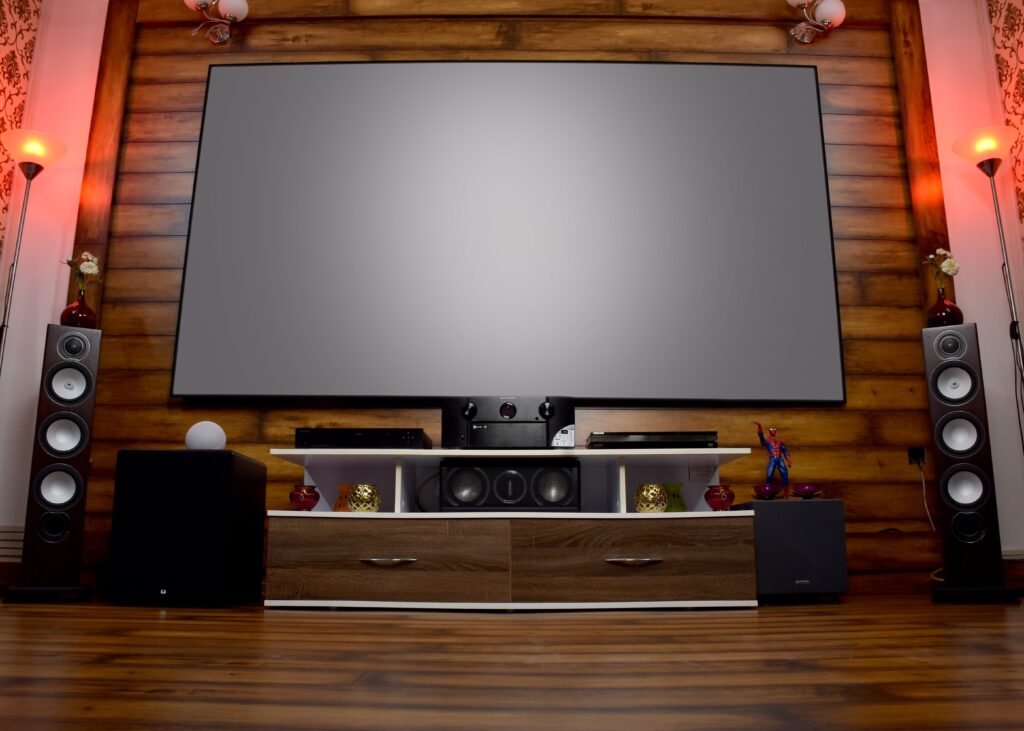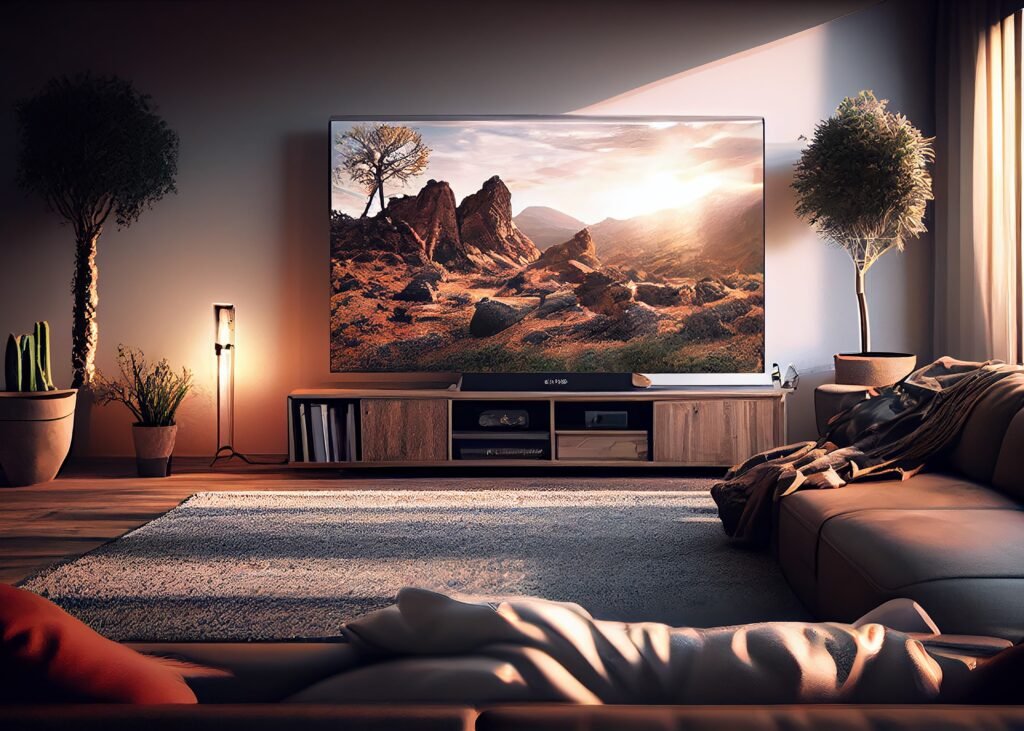Table of Contents
Welcome to our guide on creating the ultimate home theater system! In today’s fast-paced world, having a dedicated space for entertainment and relaxation is essential, and what better way to achieve that than by bringing the cinematic experience into your own home? From immersive audio to stunning visuals, a well-designed home theater system can turn any room into a captivating entertainment hub for movie nights, gaming sessions, and more. Join us as we explore the components, technology, and design considerations that go into building the perfect home theater system tailored to your preferences and lifestyle.
Whether you’re a movie buff, a gaming enthusiast, or simply seeking a cozy retreat for relaxation, our guide will help you transform your living space into a haven of entertainment and enjoyment. Let’s embark on this exciting journey together and unlock the secrets to creating your dream home theater system!
HIGH QUALITY DISPLAY

A high-quality display is the cornerstone of any home theater system, providing the visual centerpiece that brings movies, TV shows, and gaming to life. Here’s what you need to know to choose the perfect display for your home theater:
SCREEN SIZE AND RESOLUTION
Consider the size of your viewing area and the distance from the screen to determine the ideal screen size. Opt for a larger screen for a more immersive experience, but ensure it fits comfortably within your space. Choose a display with a high resolution, such as 4K or even 8K, for crisp, detailed images that showcase every nuance of your content. Higher resolution displays offer greater clarity and realism, especially when viewing high-definition or Ultra HD content.
DISPLAY TECHNOLOGY
- LED TVs: LED (Light-Emitting Diode) TVs are popular for their bright, vibrant colours, energy efficiency, and slim design. They offer excellent picture quality and are available in a range of sizes and price points.
- OLED TVs: OLED (Organic Light-Emitting Diode) TVs deliver stunning contrast and deep blacks, thanks to their individual pixel illumination. They provide superior picture quality and wider viewing angles compared to LED TVs but are more expensive.
- Projectors: Projectors are an excellent choice for larger screen sizes and dedicated home theater rooms. They offer a cinematic experience with massive screen sizes and can be paired with a high-quality projection screen or a grey wall for optimal image quality.
Experience cinema-quality entertainment at home with the TOPTRO Free Style 720p Native Resolution Projector. Boasting 4K support and 3500 lumens, it delivers stunning visuals on screens up to 150″. Equipped with Android 11, WiFi, Bluetooth, and versatile connectivity options, it’s perfect for streaming from Netflix, Prime Video, and more. Enhance your viewing experience today!
REFRESH RATE AND RESPONSE TIME
Look for a display with a high refresh rate (typically 120Hz or higher) for smoother motion handling, especially during fast-paced action scenes or gaming. A low response time (measured in milliseconds) is also important for minimizing motion blur and ghosting.
HDR SUPPORT
HDR (High Dynamic Range) technology enhances the contrast, brightness, and colour accuracy of your display, resulting in more lifelike and dynamic images. Look for displays that support HDR formats such as HDR10, Dolby Vision, or HLG (Hybrid Log-Gamma) for the best HDR performance.
SURROUND SOUND SYSTEM

A surround sound system is the heart of any home theater, enveloping you in rich, immersive audio that brings movies, music, and gaming to life. Here’s everything you need to know to choose and set up the perfect surround sound system for your home theater:
HOME THEATER RECEIVER
Start with a high-quality home theater receiver that serves as the central hub of your audio system. Look for a receiver with enough power and channels to accommodate your desired speaker setup, such as 5.1, 7.1, or even Dolby Atmos configurations. Consider features such as built-in Bluetooth, Wi-Fi, and streaming capabilities for convenient access to music and online content.
SPEAKER CONFIGURATION
Choose a speaker configuration that suits your room size, layout, and personal preferences. Common configurations include:
- 5.1 Surround Sound: Consisting of five speakers (front left, front right, center, surround left, surround right) and a subwoofer for deep bass.
- 7.1 Surround Sound: Adds two additional surround speakers for enhanced spatial effects and immersion.
- Dolby Atmos: Incorporates additional height channels for overhead sound effects, creating a more three-dimensional audio experience.
Elevate your home entertainment with the Sony HT-A3000 A Series Premium Soundbar. Featuring innovative 360 Spatial Sound Mapping, it creates an immersive surround sound experience. With Dolby Atmos support, enjoy the thrill of movies in stunning detail. Plus, experience high-resolution audio for supreme music quality. Upgrade your audio setup now!
SPEAKER PLACEMENT
Position your speakers strategically for optimal sound quality and immersion. Follow these general guidelines:
- Front Speakers: Place front left and front right speakers at ear level, equidistant from the center of your TV or screen.
- Center Speaker: Position the center speaker directly above or below your TV, aligned with the front speakers.
- Surround Speakers: Place surround speakers to the sides or slightly behind your seating area, at ear level.
- Height Speakers (for Dolby Atmos): Install height speakers above your seating area or use upward-firing speakers that bounce sound off the ceiling.
SUBWOOFER PLACEMENT
Place the subwoofer in a corner or along the front wall of the room to maximize bass response. Experiment with placement to find the optimal position for balanced bass throughout the room.
CALIBRATION AND SETUP
Use the built-in calibration tools on your home theater receiver to calibrate speaker levels, distances, and crossover settings automatically. Alternatively, manually adjust settings to fine-tune the audio for your room environment and personal preferences.
Ensure your surround sound system supports popular audio formats such as Dolby Digital, DTS, and Dolby Atmos for a wide range of content compatibility.
COMFORTABLE SEATING

Choosing the right seating for your home theater is essential for creating a comfortable and immersive viewing environment. Here’s what you need to consider when selecting seating options for your home theater:
HOME THEATER RECLINERS
Home theater recliners are specially designed for dedicated home theater rooms, providing individual seating with optimal comfort and functionality. Choose from single recliners, loveseats, or sectional configurations to accommodate your space and seating needs. Look for features like power reclining mechanisms, built-in massage functions, and LED lighting for a luxurious movie-going experience.
BEAN BAGS AND FLOOR CUSHIONS
For a casual and flexible seating option, consider bean bags or floor cushions that can be easily rearranged to suit your preferences.
- Bean bags are lightweight, portable, and available in a variety of sizes, shapes, and colours to complement your home decor.
- Floor cushions provide extra padding and support for lounging on the floor while still offering comfort and relaxation.
Experience ultimate comfort with the GIGLICK 4XL Superior-Grade Faux Leather Bean Bag. Crafted from PVC faux leather for durability, it’s upgraded with thicker, softer material for long-lasting use. Ergonomically designed and filled with EPP Polystyrene Beads, it provides optimal support and comfort. Relax in style with this versatile bean bag chair and footrest combo. Buy now!
THEATER-STYLE SEATING
Recreate the cinema experience at home with theater-style seating featuring rows of reclining seats with cup holders and armrests. Choose from manual or power reclining options, with configurations available for small or large home theater rooms. Consider adding accessories such as tray tables, LED lighting, and swivel trays for added convenience and functionality.
ROOM LAYOUT AND SPACE PLANNING
Consider the layout and size of your home theater room when selecting seating options to ensure proper spacing and arrangement for optimal viewing angles. Leave enough space between the seats and the screen to avoid neck strain and ensure an unobstructed view of the screen.
LIGHTING AND AMBIANCE

Creating the perfect ambiance in your home theater is essential for enhancing the viewing experience and immersing yourself in the magic of cinema. Here’s how to use lighting and ambiance to elevate your home theater system:
- Dimmable Lighting: Install dimmable LED lights or smart bulbs in your home theater room to adjust the brightness and set the mood for movie nights. Dim the lights to create a cozy and intimate atmosphere during movie screenings, while still providing enough illumination to navigate the room safely.
- Wall Scones and Accent Lighting: Add wall sconces or accent lighting along the perimeter of the room to create a soft, indirect glow that enhances the ambiance without causing glare on the screen. Choose lighting fixtures with adjustable brightness levels or colour temperature settings to customize the ambiance to your preferences.
- Backlighting for TV or Screen: Install LED strip lights or backlighting behind your TV or projection screen to reduce eye strain and improve contrast during movie playback. Choose RGB LED strips that allow you to adjust the colour and intensity of the backlighting to match the mood of the movie or create a dynamic visual effect.
- Choose Theater-Style Lighting: Consider installing theater-style lighting controls, such as wall-mounted dimmer switches or remote-controlled smart lighting systems, for easy adjustment of lighting levels and ambiance. Program preset lighting scenes for different viewing modes, such as “movie mode” with dimmed lights and “intermission mode” with brighter lights for bathroom breaks.
- Blackout Curtains or Blinds: Install blackout curtains or blinds on windows to block out external light sources and create a dark, theater-like environment for optimal viewing conditions. Choose curtains or blinds with light-blocking or thermal insulation properties to enhance energy efficiency and soundproofing in your home theater room.
- LED Accent Lighting: Add LED accent lighting to highlight architectural features, movie posters, or artwork in your home theater room. Use LED strip lights or spotlights with adjustable brightness and colour options to create visual interest and focal points in the room.
- Smart Home Integration: Integrate your lighting controls with a smart home automation system for seamless control of lighting, audio, and other home theater components. Use voice commands or smartphone apps to adjust lighting settings, change colours, and create custom lighting scenes with ease.
ROOM ACOUSTICS

Achieving optimal room acoustics is essential for maximizing the sound quality and immersive experience of your home theater system. Here’s how to optimize room acoustics for your home theater:
- Acoustic Treatment: Install acoustic panels or sound-absorbing materials on walls, ceilings, and floors to reduce echoes, reverberations, and sound reflections that can degrade audio quality. Choose acoustic panels with different thicknesses and densities to target specific frequency ranges and improve overall sound clarity.
- Bass Traps: Place bass traps in corners and along walls to absorb low-frequency sound waves and prevent bass buildup, which can cause boomy or muddy audio. Bass traps come in various shapes and sizes, including corner-mounted panels, triangular wedges, and cylindrical tubes, to effectively address bass issues in your room.
- Diffusers: Use acoustic diffusers to scatter sound waves evenly throughout the room and reduce standing waves, which can cause peaks and nulls in frequency response. Diffusers come in various designs, including skyline, quadratic, and binary diffusers, to break up sound reflections and create a more natural and balanced acoustic environment.
- Rug and Carpeting: Add area rugs or wall-to-wall carpeting to the floor to absorb sound reflections and reduce floor-to-ceiling reflections, especially in rooms with hard surfaces like wood or tile. Choose thick, dense rugs or carpets with sound-absorbing properties to improve acoustics and create a warmer, more inviting atmosphere in your home theater.
- Acoustic Analysis and Treatment Planning: Conduct an acoustic analysis of your room using specialized software or consulting with an acoustics professional to identify acoustic problems and develop a customized treatment plan. Consider factors such as room dimensions, construction materials, furnishings, and usage patterns when planning acoustic treatment to ensure optimal sound quality and performance.
REMOTE CONTROL AND AUTOMATION

Incorporating remote control and automation into your home theater system offers convenience, flexibility, and enhanced usability. Here’s how to streamline the control of your home theater components with remote control and automation:
- Universal Remote Control: Invest in a universal remote control that consolidates the operation of multiple devices, including your TV, audio receiver, streaming media player, Blu-ray player, and more. Choose a universal remote with customizable buttons, touch-screen displays, and intuitive interfaces for easy navigation and control of your home theater system.
- Smart Home Integration: Integrate your home theater components with a smart home automation system, such as Amazon Alexa, Google Assistant, or Apple HomeKit, for seamless control using voice commands or smartphone apps. Use voice commands to turn on your TV, adjust volume levels, switch inputs, and launch streaming apps without touching a remote control or smartphone.
- Programmable Macros and Activities: Create custom macros or activities to automate common tasks and routines in your home theater. For example, create a “movie night” activity that turns on your TV, dims the lights, adjusts the audio settings, and launches your favourite streaming app with a single button press. Program macros to perform multiple actions in sequence, such as powering on/off multiple devices, switching inputs, and adjusting volume levels, to simplify complex tasks and streamline your home theater experience.
- Smartphone Apps and Touchscreen Interfaces: Use smartphone apps or touchscreen interfaces to control your home theater components directly from your mobile device or tablet. Download manufacturer-specific apps for your TV, audio receiver, streaming media player, and other devices to access advanced settings, customize preferences, and troubleshoot issues remotely.
- Infrared (IR) Repeaters and Extenders: Extend the range and coverage of your remote control signals using infrared (IR) repeaters or extenders, especially in large or multi-room home theater setups. Place IR repeaters or extenders strategically to relay remote control signals from your universal remote to hidden or distant devices, such as AV cabinets or equipment closets.
In conclusion, a home theater system offers more than just entertainment—it’s a gateway to immersive experiences and cherished memories. By carefully selecting components, optimizing setup, and adding personal touches, you can create a space that brings the magic of the cinema right into your home. Whether it’s movie nights with family, gaming sessions with friends, or moments of relaxation, your home theater system is sure to become a beloved centerpiece of your home. Welcome to the ultimate entertainment experience.
MORE LIFESTYLE RELATED ARTICLES

